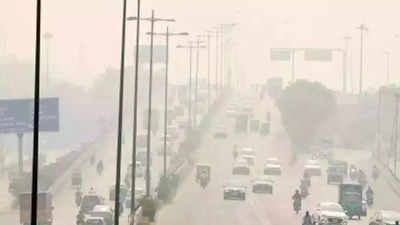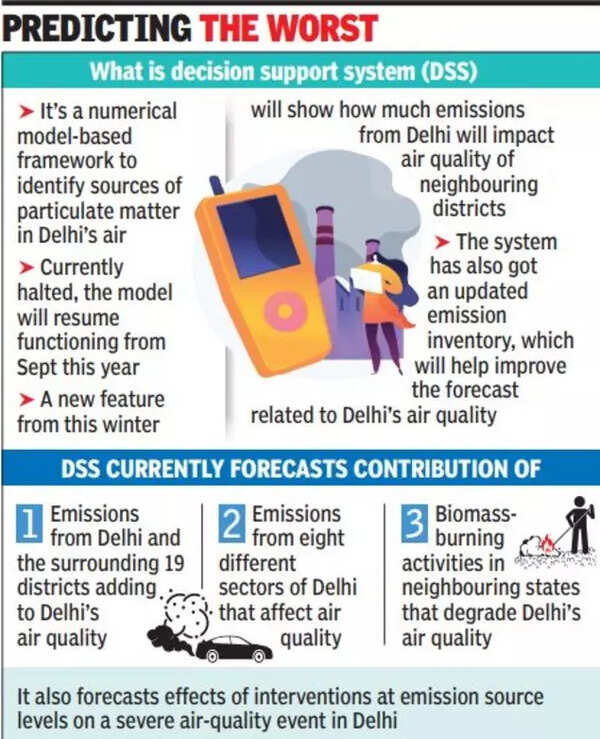- News
- City News
- delhi News
- System to identify pollution sources back in 2.0 version
Trending
System to identify pollution sources back in 2.0 version
The DSS by IITM, Pune, enhances Delhi's air quality forecasting with updated 2023 emission inventory and VIIRS satellite for PM2.5 predictions. Sector-wise emission reduction scenarios help predict air quality improvements.

NEW DELHI: The decision support system (DSS), which identifies sources of pollution in Delhi’s air, will resume functioning from Sept this year with some new features.

The system, which works only in winter and is stopped from March to August, currently forecasts the contribution of emissions in Delhi’s air quality from 19 neighbouring districts. Now, the system will also forecast how Delhi’s emissions impact the air of eight surrounding districts in NCR.The system has also received an updated emission inventory of 2023, which would improve the forecasting model.
The DSS, developed by Indian Institute of Tropical Meteorology (IITM), Pune, is a numerical model-based framework to forecast Delhi’s air quality and sources of local and regional pollution which can impact the air. The system gives forecasts the result of biomass burning activities in neighbouring states. “From Sept this year, we will introduce another feature on the percentage contribution of emissions from Delhi in air quality of some neighbouring districts of NCR,” Sachin Ghude, scientist and head of the air quality forecasting group, IITM, said.
For determining the contribution of stubble burning in Delhi’s PM2.5, the system was using the MODIS satellite. However, it will switch to the higher-resolution VIIRS satellite in the winter season.
Launched in October 2021, this year the DSS made forecasts till March 5.
Apart from predicting local and non-local fractional contribution to PM2.5 in Delhi over the next 120 hours, DSS gives different scenarios on the impact on Delhi’s air quality if emission from one sector is reduced by 20%, 40% or 60%. For instance, if the emission from transport is reduced by 20%, the system can predict how much the air quality is expected to improve.

The system, which works only in winter and is stopped from March to August, currently forecasts the contribution of emissions in Delhi’s air quality from 19 neighbouring districts. Now, the system will also forecast how Delhi’s emissions impact the air of eight surrounding districts in NCR.The system has also received an updated emission inventory of 2023, which would improve the forecasting model.
The DSS, developed by Indian Institute of Tropical Meteorology (IITM), Pune, is a numerical model-based framework to forecast Delhi’s air quality and sources of local and regional pollution which can impact the air. The system gives forecasts the result of biomass burning activities in neighbouring states. “From Sept this year, we will introduce another feature on the percentage contribution of emissions from Delhi in air quality of some neighbouring districts of NCR,” Sachin Ghude, scientist and head of the air quality forecasting group, IITM, said.
The emissions inventory currently being used was last updated in 2018, but DSS has now received an updated emission inventory of 2023. The updated inventory is important because forecasting pollution levels depend on the inventory, which has data of different sources of pollution in the city. The updated emission inventory for Delhi has been prepared by the IITs in Kanpur and Delhi and Delhi Pollution Control Committee. “Based on this inventory, the system will provide forecasts in the winter season,” said Ghude.
For determining the contribution of stubble burning in Delhi’s PM2.5, the system was using the MODIS satellite. However, it will switch to the higher-resolution VIIRS satellite in the winter season.
Launched in October 2021, this year the DSS made forecasts till March 5.
Apart from predicting local and non-local fractional contribution to PM2.5 in Delhi over the next 120 hours, DSS gives different scenarios on the impact on Delhi’s air quality if emission from one sector is reduced by 20%, 40% or 60%. For instance, if the emission from transport is reduced by 20%, the system can predict how much the air quality is expected to improve.
We also published the following articles recently
80% of CPCB funds to check Delhis air pollution unspent
CPCB disbursed 20% of collected funds to tackle air pollution in Delhi-NCR. Spending criticized for not directly reducing pollution. Transparency and addressing public needs like green cover and waste management are urged.
CPCB disbursed 20% of collected funds to tackle air pollution in Delhi-NCR. Spending criticized for not directly reducing pollution. Transparency and addressing public needs like green cover and waste management are urged.
What is satellite-based toll collection system, how will it be different from FASTag, and other details
Nitin Gadkari introduces India's new satellite-based toll collection system, enhancing toll efficiency and commuter convenience. The system leverages GNSS, GPS, and GAGAN technologies, along with digital wallets, to modernize transportation infrastructure.
Nitin Gadkari introduces India's new satellite-based toll collection system, enhancing toll efficiency and commuter convenience. The system leverages GNSS, GPS, and GAGAN technologies, along with digital wallets, to modernize transportation infrastructure.
Air pollution may be a local issue but it can weigh on a voter's mind
Mumbai battles chronic air quality issues, illegal hawking, and encroachments. Infrastructure projects ongoing, but concerns remain over water scarcity and Dharavi redevelopment impact. Urgent need for green spaces and comprehensive development.
Mumbai battles chronic air quality issues, illegal hawking, and encroachments. Infrastructure projects ongoing, but concerns remain over water scarcity and Dharavi redevelopment impact. Urgent need for green spaces and comprehensive development.
End of Article
FOLLOW US ON SOCIAL MEDIA










